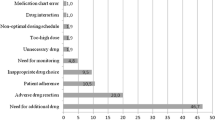Abstract
Purpose
Most drugs are excreted in maternal milk and may therefore be ingested by children during breastfeeding. Data concerning the safety of the use of drugs by breastfeeding women are patchy, and almost nothing is known about this issue for many drugs.
Methods
The aim of this study was to describe the adverse drug reactions of drugs transmitted in breast milk on the basis of the data collected in the French Pharmacovigilance Database. All spontaneous reports of adverse drug reactions (ADRs) in breastfed infants recorded in the National Pharmacovigilance Database by the 31 French regional pharmacovigilance centres between 1984 and June 2011 were investigated.
Results
Between January 1985 and June 2011, 276 adverse drug reactions in 174 breastfed children were notified to the French Pharmacovigilance Network. The most frequently reported adverse drug reactions were neurological (28.6 %) and gastrointestinal (20.3 %). Sixty-five of the adverse drug reactions recorded were considered to be serious (37.4 %). The results of our study confirm that certain drugs were frequently implicated in serious adverse drug reactions. Two cases of ADRs (1.1 %) had a ‘certain’ causality score (I4) and 13 (7.5 %) a ‘likely’ score (I3). The suspected drugs include antiepileptic drugs, opiate analgesics and benzodiazepines. These results also demonstrate that some drugs that were thought to be anodyne or for which no data were available, such as ketoprofen and hydroxyzine, may be implicated in adverse effects. Finally, these data show that certain drugs, like pseudoephedrine, which should not be used during breastfeeding, were nevertheless implicated in several of the adverse drug reactions recorded.
Conclusion
This study shows that ADR via breastfeeding are rarely reported due to low awareness or low occurrence of ADR via breast milk. These results highlight the need for additional pharmacokinetic, clinical and epidemiological studies, given the paucity of published data. They also demonstrate the need to improve information for the general public about drugs and self-medication during breastfeeding.


Similar content being viewed by others
References
Ministère de la Santé. Enquête nationale périnatale (2010) http://www.sante.gouv.fr
Bavoux F, Elefant E (1989) Undesirable effects of drugs during breast feeding. Rev Prat 39:881–882
Davanzo R, Dal Bo S, Bua J, Copertino M, Zanelli E, Matarazzo L (2013) Antiepileptic drugs and breastfeeding. Ital J Pediatr 39:50
Sachs HC, Committee on drugs (2013) The transfer of drugs and therapeutics into human breast milk: an update on selected topics. Pediatrics 132:e796–e809
Lacroix I, Arrault-Olanora A, Berrebi A, Montastruc J-L, Damase-Michel C (2005) Drug use during postpartum period: a comparative study between lactating and non-lactating women. J Pediatr 18:379–385
Ito S, Blajchman A, Stephenson M, Eliopoulos C, Koren G (1993) Prospective follow-up of adverse reactions in breast-fed infants exposed to maternal medication. Am J Obstet Gynecol 168:1393–1399
Anderson PO, Pochop SL, Manoguerra AS (2003) Adverse drug reactions in breastfed infants: less than imagined. Clin Pediatr (Phila) 42:325–340
Begaud B, Evreux JC, Jouglard J, Lagier G (1985) Imputation of the unexpected or toxic effects of drugs. Actualization of the method used in France. Therapie 40:111–118
Begaud B, Martin K, Haramburu F, Moore N (2002) Rates of spontaneous reporting of adverse drug reactions in France. JAMA 288:1588
Hale TW (2008) Medications and mothers ‘milk, tenth edition. Pharmasoft publishing 1172p
Cole T, Bellizzi MC, Flegal KM, Dietz WH (2000) Establishing a standard definition for child overweight and obesity worldwide: international survey. Br Med J 320:1240–1243
Newport DJ, Pennell PB, Calamaras MR, Ritchie JC, Newman M, Knight B, Viguera AC, Liporace J, Stowe ZN (2008) Lamotrigine in breast milk and nursing infants: determination of exposure. Pediatrics 122:223–231
Nordmo E, Aronsen L, Wasland K, Småbrekke L, Vorren S (2009) Severe apnea in an infant exposed to lamotrigine in breast milk. Ann Pharmacother 43:1893–1897
Precourt A, Morin C (2011) Use of lamotrigine during breastfeeding: descriptive analysis of our population and report of five cases of premature neonates. Breastfeed Med 6:S-18
Kacirova I, Grundmann M, Brozmanova H (2011) Serum levels of lamotrigine in breastfeeding mothers, maternal milk and nursed infants. Basic Clin Pharmacol Toxicol 109:135–136
Naumburg EG, Meny RG (1988) Breast milk opioids and neonatal apnea. Am J Dis Child 142:11–12
Koren G, Cairns J, Chitayat D, Gaedigk A, Leeder SJ (2006) Pharmacogenetics of morphine poisoning in a breastfed neonate of a codeine-prescribed mother. Lancet 368:704
Kunka RL, Yong CL, Ladik CF, Bates TR (1985) Liquid chromatographic determination of propoxyphene and norpropoxyphene in plasma and breast milk. J Pharm Sci 74:103–104
Rubin ET, Lee A, Ito S (2004) When breastfeeding mothers need CNS-acting drugs. Can J Clin Pharmacol 11:257–266
Jacqz-Aigrain E, Serreau R, Boissinot C, Popon M, Sobel A, Michel J, Sibony O (2007) Excretion of ketoprofen and nalbuphine in human milk during treatment of maternal pain after delivery. Ther Drug Monit 29:815–818
Author information
Authors and Affiliations
Corresponding author
Electronic supplementary material
Below is the link to the electronic supplementary material.
ESM 1
(DOC 21 kb)
Rights and permissions
About this article
Cite this article
Soussan, C., Gouraud, A., Portolan, G. et al. Drug-induced adverse reactions via breastfeeding: a descriptive study in the French Pharmacovigilance Database. Eur J Clin Pharmacol 70, 1361–1366 (2014). https://doi.org/10.1007/s00228-014-1738-2
Received:
Accepted:
Published:
Issue Date:
DOI: https://doi.org/10.1007/s00228-014-1738-2



